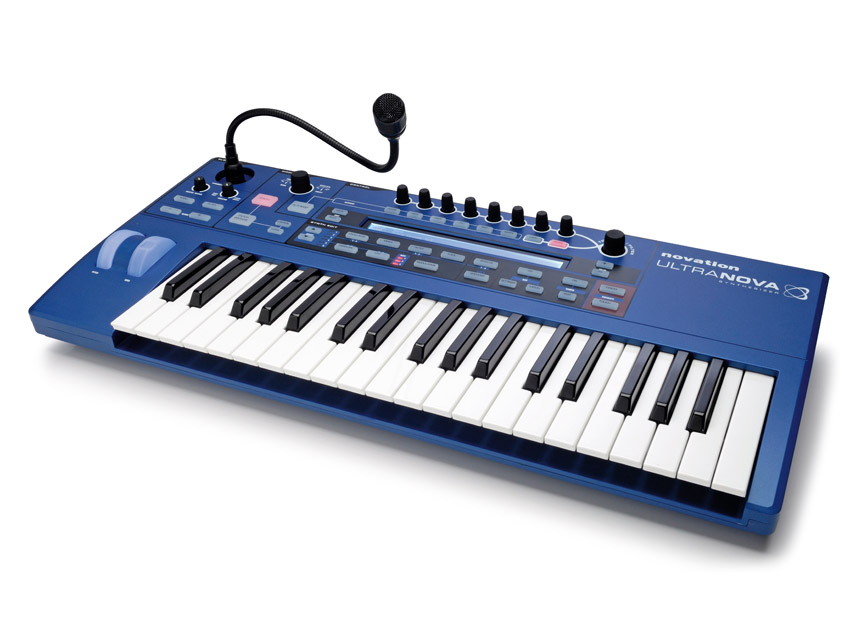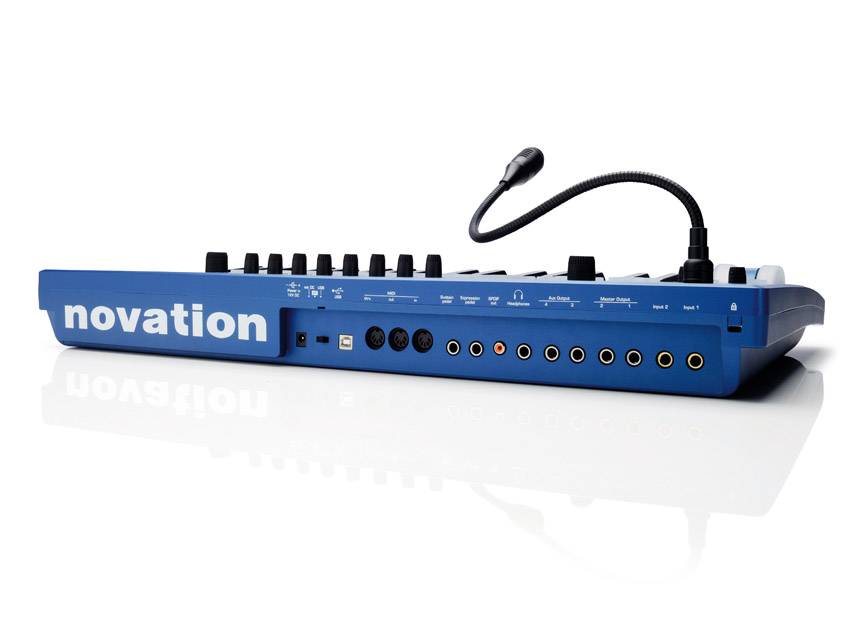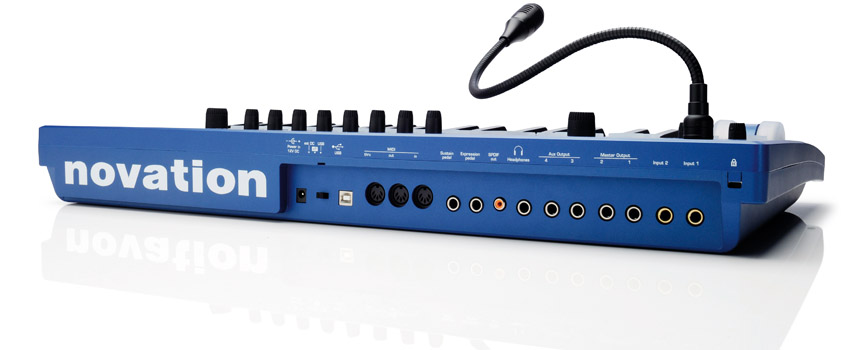MusicRadar Verdict
The UltraNova does everything well but is up against plenty of stiff competition.
Pros
- +
18-voice synth engine with a dazzling array of options. 12-band vocoder and useful selection of effects. Touch-sensitive tweak controls for fast access to key parameters.
Cons
- -
No particularly unique features.
MusicRadar's got your back

Novation UltraNova

Novation UltraNova
In recent years, Buckinghamshire's Novation have been best known for their excellent range of MIDI keyboards and controllers, but trace the company's history back a few years and you'll uncover a much-loved range of synths.
The UltraNova is the company's first new synth since 2007's Xio, but to understand its heritage we need to go back another decade. In many respects, the UltraNova is a modernised version of the SuperNova, an early virtual analogue classic.
"It has no major weaknesses, making its main strength the fact that it's a genuine all-rounder."
However, the UltraNova is much more than just a repackaging of the old SuperNova technology. This keyboard has plenty of tricks up its sleeve to help it compete with the best of the 21st century market.
Hands on
Pulling the UltraNova from its packaging, it's pleasing to see that the finish and build quality are well up to scratch for a synth in this price range. Aesthetically, it's something of a nineties throwback, the blue plastic construction and red illuminated buttons vaguely bringing to mind techy classics like the Korg Prophecy and Triton.
With an enclosure that's light enough to transport to gigs but solid enough to withstand a bit of abuse, the build quality strikes a nice balance.
Firing up some of the presets, the velocity and aftertouch-sensitive keyboard is immediately impressive, offering a nice semi-weighted feel with good expressive control while the wheels are the smooth, rubberised type that are favoured by Novation on the Nocturn Keyboard and Remote SL.
Synth architecture
The UltraNova's synthesis engine is entirely digital, but is built around familiar subtractive, virtual analogue architecture. Three oscillators, two ring modulators and one noise source per voice are mixed and fed into the filter section and then on to the amp.
Envelopes 1 and 2 are routed to the amp section and the filter section respectively, while envelopes 3-6 and the three LFOs are used for modulation. From the output of the amp, five FX slots allow the sound to be processed before it gets passed to the stereo outputs.
What's very impressive for a synth in this price range is the scope of each section. Each oscillator offers a staggering 70 waveforms, from basic analogue standards through to digital waves and wavetables.
Two filters can be selected from a choice of 14 (essentially 6, 12, 18 or 24dB/oct low-pass and high-pass plus six combinations to form band-pass filters), each one with a distortion control on its input.
Twenty modulation sources (envelope generators, LFOs, aftertouch, velocity, keytracking, mod wheel and expression pedal) can be routed to 66 destinations, including modulation sources themselves.
For what's potentially a very complex synth, it's also refreshing to see that Novation have considered the fact that not every buyer will be as well versed in the principles of synthesis as someone with years of sound design experience under their belt.
The UltraNova's manual contains a clear and concise five-page tutorial on basic sound design principles, providing a focussed introduction for beginners or a good recap for experienced musicians.
How does it sound?
The UltraNova's presets ably demonstrate everything from huge bass patches to screaming leads via sweet analogue-sounding pads and even the odd passable impression of acoustic instruments.
Impressive as they may initially appear, we found most of the presets to be so heavily processed that they were more a demo of the effects than the synth itself. Showing off the processing potential is one thing, but bypassing the default choruses and delays will make most of the sounds much easier to fit in your mixes.

To describe the UltraNova as a virtual analogue synth doesn't really do it justice in terms of the range of sounds it can produce. Simple analogue-style sounds are easy to program, but digging a bit further reveals digital FM effects, chiptune-style 8-bit timbres, great evolving wavetable sounds and a range of heavily modulated modern virtual analogue patches.
The presets really only show a small part of the UltraNova's potential, and digging into the editing options reveals a very versatile synth with modulation options by the bucketload and sound sculpting capabilities to rival much more expensive competition.
With 18 note polyphony, great sounding unison options and linear or exponential portamento, the only major omission is any kind of multi-timbral functionality. Most entry-level users probably won't be put off by its absence, but the ability to layer patches and create complex hybrid tones would be a nice addition for more experimental types.
Software Editor
As with any LCD-based programming interface, the user-friendliness of the UltraNova diminishes as you dig deeper into the synth's capabilities. Editing even relatively simple settings can soon become frustrating as you're presented with abbreviated parameter names and obscure acronyms.
As we set an oscillator to the StrnMch2 waveform and tweaked the O3Pw/Idx setting we found ourselves wishing Novation had stretched the budget a bit and specified a bigger screen.
To make up for the keyboard's weaknesses in this department, the UltraNova is supplied with a software editor, which loads as an instrument plug-in in your DAW, and a standalone patch librarian.
Although the plug-in is simply a controller (it doesn't produce sound, you'll have to set up an input to capture the synth's output), it simplifies the process of controlling the hardware and should act as a good bridge for producers who are used to software synths and working with virtual instruments.
Every one of the synth's settings can be controlled through the plug-in and the page-based editing setup is certainly preferable to editing via the LCD screen.
Special FX
Since the microKorg took the world by storm back in 2002, a built-in vocoder has been a must-have feature in the virtual analogue synth market. The UltraNova follows suit, with a 12-band vocoder that's capable of creating everything from classic robotic vocal effects to, er, more robotic vocal effects.
The vocoder may steal the headlines, but it's not the only effect in the UltraNova's armoury and the collection of distortion, compressor, chorus/phase, delay, reverb, 'Gator' and EQ are all very usable options.
The UltraNova's excellent integration with your DAW also sets it apart from most synths. In addition to the editor plug-in and patch librarian, full Novation Automap support means the synth also functions as a controller for other software.
The integrated 2-in, 4-out audio interface offers passable if unremarkable sound quality but expands the versatility even further. The UtraNova's effects and processing options are backed up by a series of performance features which make it even easier to get immediate results.
The most impressive of all is the ability to assign up to eight parameters to the touch-sensitive 'tweak' controllers across the top of the synth. Tapping the Tweak button reveals each encoder's setting on the LCD, while the most recently touched parameter is automatically assigned to the larger Touch encoder to the right.
Alternatively, the Touch encoder can be locked to any parameter or automatically assigned to filter 1 cutoff at the touch of a button. In use, it makes it very easy to control a handful of key parameters simultaneously without needing to work your way through menus as you play.
The arpeggiator is flexible and easy to program, with dedicated On, Latch and Settings keys on the front panel and the tweak encoders allowing instant access to all the key parameters.
Like all of the UltraNova's tempo-synced effects and LFOs, the arpeggiator can sync to an external MIDI clock or the synth's internal clock). Likewise, the chord memory function is activated via a dedicated button and easy to program via the LCD.
All-rounder
With an RRP of £599 but a street price closer to £500, the UltraNova is undoubtedly good value. The £400-600 market sector is already competitive and Novation's offering is sure to give potential Gaia or R3 buyers something to think about.
Overall, the UltraNova gives solid results, providing a versatile range of sonic options while never quite offering anything truly outstanding or unique. At the same time, it has no major weaknesses, making its main strength the fact that it's a genuine well thought out all-rounder.
With a powerful synth engine, built-in vocoder and effects, audio interface, and VST integration, the UltraNova is an excellent option for anyone looking to step outside of the box.
Future Music is the number one magazine for today's producers. Packed with technique and technology we'll help you make great new music. All-access artist interviews, in-depth gear reviews, essential production tutorials and much more. Every marvellous monthly edition features reliable reviews of the latest and greatest hardware and software technology and techniques, unparalleled advice, in-depth interviews, sensational free samples and so much more to improve the experience and outcome of your music-making.
“We were arguing a lot and we were miserable”: How Green Day exceeded expectations with their most ambitious song
"There’s plenty for us guitarists to learn – and ‘less is more’ is the overriding lesson": how to play like George Harrison on The Beatles' Abbey Road
“They didn’t like Prince’s bikini underwear”: Prince’s support sets for the The Rolling Stones in 1981 are remembered as disastrous, but guitarist Dez Dickerson says that the the crowd reaction wasn’t as bad as people think










